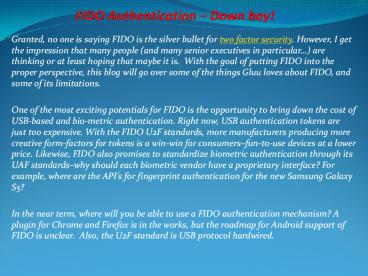FIDO Authentication – Down boy! PowerPoint PPT Presentation
Title: FIDO Authentication – Down boy!
1
FIDO Authentication Down boy!
- Granted, no one is saying FIDO is the silver
bullet for two factor security. However, I get
the impression that many people (and many senior
executives in particular) are thinking or at
least hoping that maybe it is. With the goal of
putting FIDO into the proper perspective, this
blog will go over some of the things Gluu loves
about FIDO, and some of its limitations. - One of the most exciting potentials for FIDO is
the opportunity to bring down the cost of
USB-based and bio-metric authentication. Right
now, USB authentication tokens are just too
expensive. With the FIDO U2F standards, more
manufacturers producing more creative
form-factors for tokens is a win-win for
consumersfun-to-use devices at a lower price.
Likewise, FIDO also promises to standardize
biometric authentication through its UAF
standardswhy should each biometric vendor have a
proprietary interface? For example, where are the
APIs for fingerprint authentication for the new
Samsung Galaxy S5? - In the near term, where will you be able to use a
FIDO authentication mechanism? A plugin for
Chrome and Firefox is in the works, but the
roadmap for Android support of FIDO is unclear.
Also, the U2F standard is USB protocol hardwired.
2
Of course, USB and biometric authentication are
just two ways you could identify a person. There
are other cognitive, behavioral, PKI, and NFC
mechanisms that also make sense in many
situations. In my SXSW prezi I present over
thirty different mechanisms to identify a person.
And this number probably represents less than 10
of the technologies available to organizations.
For many organizations, FIDO will be just one of
many authentication mechanisms that are
supported. In fact, using FIDO only makes sense
if the person has a certain kind of device in
their hands. One aspect of website
authentication that many organizations dont
understand is that identifying the person is just
one step in the workflow for authentication. Even
assuming a positive authentication is made, many
websites consider a number of contextual clues to
assist in fraud detection. Is the geo-location of
the IP address in a foreign country? Are there
hooks to intrusion detection, central logging, or
threat information sharing services?
Authentication is a critical event frequently
with special business logic required by the
organization. The mechanism of authenticationwhic
h may be FIDOis just one part of that business
logic. Recently, there was a Microsoft study
that surveyed many different types of
authentication. What it found is that while some
mechanisms were more secure, and some more
usable, the main impediment to the adoption of
two-factor were deployment challenges. Will FIDO
improve deployability of 2FA? Not significantly.
Will it make USB and biometric authentication
cheaper? YES!
3
One of the conundrums we are facing is why is
FIDO getting all the attention, while OpenID
Connects delivery of a final specification has
been for the most part un-noticed. At first
glance, federation protocols like Connect dont
seem to provide a solution for two-factor
authentication. In fact, Connect is neutral on
how the person is authenticated. However, here
at Gluu we see everything around authentication
as having the greatest impact on deploy-ability.
In order to get developers of mobile applications
and websites to support strong authentication, we
need a lingua franca. App developers want to be
able to select FIDO authentication, or phone
authentication, or even password
authenticationdepending on the situation.
Tightly bundling an application to a low-level
authentication protocol like FIDO would be just
as bad as sending the username / password SELECT
statement to the database. OpenID Connect
provides a higher level interface between the
application and the domain that is authenticating
the person. In order to reduce the deployment
challenge of strong authentication, we need to
make it brain dead easy for developers who are
writing custom applications, and for system
administrators who are configuring off-the-shelf
enterprise software and SaaS services. Dont get
me wrong, FIDO is great. But it is possible that
the FIDO standards will primarily be used in an
organizations federation platformnot directly
in its applications.
4
One last thought strong authentication is only a
partial success. The trick is knowing when to
elevate from a less secure type of
authentication, or when to step-up
authentication. To specify the authentication
policies for APIs, an authorization protocol
like the User Managed Access protocol is needed.
If we design only for strong authentication and
SSO, we will be setting the bar too
low. Article Resource- http//thegluuserver.word
press.com/2014/05/16/how-to-benchmark-ox-for-a-lar
ge-scale-deployment/

